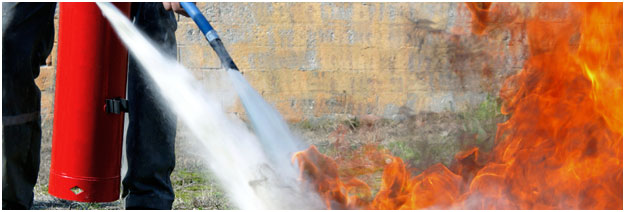
Here at Waldon Security we can help to improve fire safety in your home or business by ensuring you have the correct fire extinguishers and fire safety equipment. We can also assist with fire extinguisher servicing.
There are 5 different classes of fire, and it is important to understand that different fire extinguishers or fire safety equipment should be used to tackle different kinds of fire.
Below is a list of the different kinds of extinguishers. Fire extinguisher colours can quickly help you to identify what kind they are and what sort of fire they can be used to tackle. We stock a full range of fire extinguishers. To explore the right one please use the guide below or do call our team on 01726 65636.
Water – for use on wood, paper, textiles and other carbonaceous materials. All water extinguishers have a red label.
Can be used on the following class of fires: A
Foam – for use on wood, paper, textiles and other carbonaceous materials as well as flammable liquids, petrol and spirits. Foam extinguishers have a cream label.
Can be used on the following class of fires: A, B
Dry Powder – for use on wood, paper, textiles and other carbonaceous materials. Flammable liquids, petrol and spirits. Flammable gasses (for example propane and butane). Powder extinguishers have a blue label.
Can be used on the following class of fires: A, B, C, E
Fires caused by electrical equipment where electric current may be present.
M28/L2 Dry Powder – for use on fires involving burning metals.
Can be used on the following class of fires: D
CO2 Gas – for use on flammable liquids, petrol and spirits. Fires caused by electrical equipment where electric current may be present. Carbon Dioxide Extinguishers (CO2) have a black label.
Can be used on the following class of fires: B, E
Wet Chemical – for use on wood, paper, textiles and other carbonaceous materials. Cooking oil and fat (for example olive oil, maize oil, lard and butter). Wet chemical extinguishers have a yellow label.
Can be used on the following class of fires: A, F
Of course the best way to improve fire safety in your home or business is to take steps to prevent fires. Here are a few tips and free resources to help you minimize the risk.
Read through your fire risk assessment
Every commercial property must have a fire risk assessment, and reading through this is a helpful way for you to identify any risks and ensure you have the right equipment and procedures in place.
If you are a homeowner, it is also a good idea to to do a fire risk assessment and have a plan of what to do in the event of fire which all members of the household are aware of. Making sure everyone has fire extinguisher training is also important.
Check fire and smoke alarms are working
Your fire risk assessment should document when these were last tested, if not, then now is a good time to check again and update your records.
Check fire safety equipment is working
Check your fire extinguishers and other fire safety equipment is working, clearly labelled and signposted and that everyone who regularly uses the premises knows how to use them.
Ensure electrical appliances have been tested
Check your records to find out if all electrical appliances and boilers have been tested and are up to date. Arrange tests if necessary and record the results and dates of tests.
Make sure any household members and staff know important fire safety advice
Employers have a responsibility to ensure staff have fire safety training, but temporary staff and at home, family members and guests should also know where fire exits are and fire evacuation procedures; where firefighting equipment is and how to use it.
Record who is on the premises at any time
It may be likely that some staff work alone or visit the business premises at irregular hours during holiday season, so make sure you have a visitors log or clear way for authorities to know quickly if anyone is likely to be on the premises in the event of a fire.
Unplug any unnecessary electrical appliances
Immediately before leave the property or go to bed, ensure any appliances or devices which do not need to be plugged in are physically unplugged from the socket. This has the benefit of saving you money too as many appliances use a surprising amount of electricity when simply on standby mode.
Use alarm systems
Nowadays you can have monitors which plug directly into the electrical sockets and are connected to your handheld devices. Upon signs of fire manifesting or smoke being present, the monitors will notify you through an app, via text messages or email. You can then take actions accordingly. We also offer a monitoring service to help handle both real and false alarms.
Close internal doors
Before you go to bed or leave a property, close all internal doors. This will contain a fire and can give you vital time to get out safely or minimise the damage a fire can do.
Before you leave a property for an extended period of time:
Click here to see the goverments fire safety in the workplace guidelines
For fire safety tips to protect your business during the holidays read our blog: Fire Safety Advice Before and During Your Holiday

